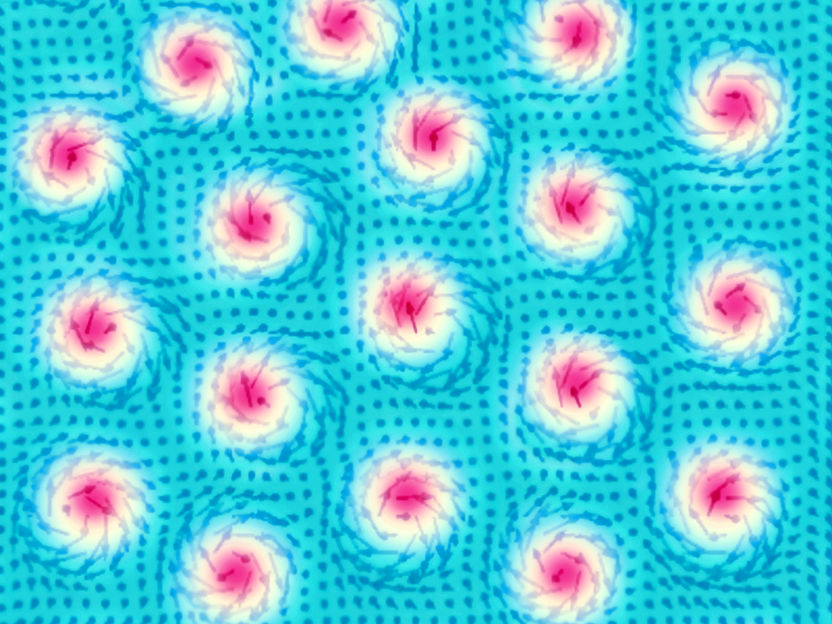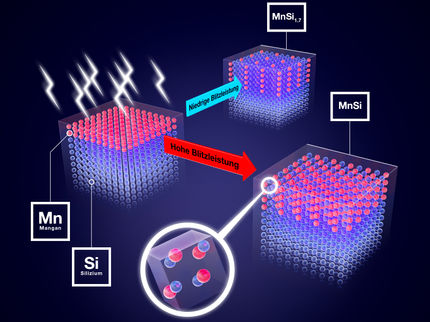Dynamic pattern of Skyrmions observed
Tiny magnetic vortices known as skyrmions form in certain magnetic materials, such as Cu2OSeO3. These skyrmions can be controlled by low-level electrical currents – which could facilitate more energy-efficient data processing. Now a team has succeeded in developing a new technique at the VEKMAG station of BESSY II for precisely measuring these vortices and observing their three different predicted characteristic oscillation modes (Eigen modes).

The illustration demonstrates skyrmions in one of their Eigen modes (clockwise).
© Yotta Kippe/HZB
Cu2OSeO3 is a material with unusual magnetic properties. Magnetic spin vortices known as skyrmions are formed within a certain temperature range when in the presence of a small external magnetic field. Currently, moderately low temperatures of around 60 Kelvin (-213 degrees Celsius) are required to stabilise their phase, but it appears possible to shift this temperature range to room temperature. The exciting thing about skyrmions is that they can be set in motion and controlled very easily, thus offering new opportunities to reduce the energy required for data processing.
Three different Eigenmodes expected
Theoretical work had predicted that it should be possible to use a high-frequency electric field to excite a group of skyrmions in the sample so that their cores will rotate all together, synchronously like a fish swarm, clockwise or counter-clockwise, or alternatively they can even exhibit a “breathing” motion.
Now a team has succeeded in measuring the dynamics of these skyrmions in detail for the first time using a single-crystal sample of Cu2OSeO3. “Conventional laboratory methods like ferromagnetic resonance, cannot detect directly deflection of the spins in the skyrmion phase and are therefore not suitable for observing selectively their excitations. Therefore, we had to come up with something new“, explains Prof. Christian Back, from Technical University of Munich.
First experimental observation at VEKMAG
The team succeeded at BESSY II in combining a spin-resolving method with an external microwave field. „The resonant magnetic scattering technique when combined with magnetic vectorial external fields shows where the spins are located in the lattice and how they are oriented in space, and all these for each elemental spin species that may exist in the specimen“, explains Dr. Florin Radu, at the Helmholtz-Zentrum Berlin (HZB), a physicist who developed and set up the VEKMAG end station in cooperation with partners from the Universität Regensburg, Ruhr University Bochum, and Freie Universität Berlin. The construction and continuing development of the VEKMAG station are supported by the German Federal Ministry of Education and Research (BMBF) and HZB.
Using electric field induced ferromagnetic resonance excitation and recording the x-ray intensity of a so called Bragg peak, the research group demonstrated experimentally for the first time that all three characteristic oscillation modes occur in Cu2OSeO3 – the team observed magnetic skyrmions turning clockwise, counterclockwise, and expanding and contracting ("breathing" mode). Those modes can be switched and turned around by changing the frequency of the microwave field: Each dynamic mode is achieved for a certain frequency, which further depends on the external magnetic field as well as on other intrinsic parameters of the sample. “This is a first step towards phase specific characterization of controlled skyrmion’s gyrational motion”, Radu says.
Original publication
Other news from the department science

Get the chemical industry in your inbox
By submitting this form you agree that LUMITOS AG will send you the newsletter(s) selected above by email. Your data will not be passed on to third parties. Your data will be stored and processed in accordance with our data protection regulations. LUMITOS may contact you by email for the purpose of advertising or market and opinion surveys. You can revoke your consent at any time without giving reasons to LUMITOS AG, Ernst-Augustin-Str. 2, 12489 Berlin, Germany or by e-mail at revoke@lumitos.com with effect for the future. In addition, each email contains a link to unsubscribe from the corresponding newsletter.

























































